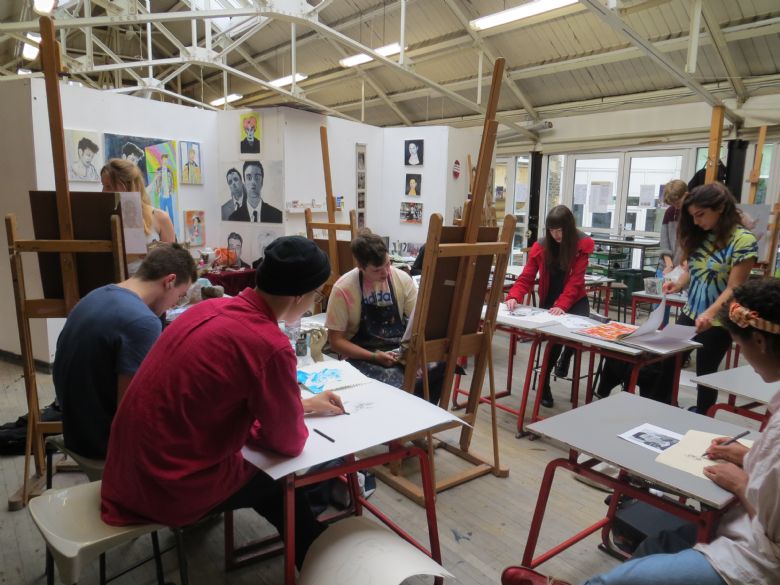Fine Art
Art at A Level is designed to give you an interesting and varied experience of the subject at a higher level than GCSE whilst building on existing skills and understanding. You will be using a wide range of materials and experimenting with ideas. There will be opportunities to learn about techniques such as oil paint, screen printing and sculptural materials.
We will also include life drawing, gallery trips and sound foundation knowledge of Art History. The units encourage you to develop your own ideas and style, but the course does have a structure which is designed to broaden and deepen your understanding of artists and art skills.
To succeed you will need to be able to plan and develop ideas in a creative way and be able to finish your work for display at the end of the course.
The A Level runs from September in Year 12 to final assessment in June in the second year of study. You will be tackling a range of projects in the first year and a half, which will come together to form your coursework unit. You will then produce a further unit in response to the exam theme in the spring term of the final year. The coursework unit is worth 60% and the exam unit is worth 40%.
Part of the coursework unit in the A Level course is a formal written and illustrated essay on an art or design topic of your own choice.
Many of our students go on to Art Foundation courses at the major art schools. Following this they take up places on degree courses in areas such as graphics, fashion, illustration, fine art, printed and woven textiles and stage design.
See also course entries under: Fine Art, History of Art, Photography
Entry Requirements: As stated in the Admission Policy
Special Requirements: Including grade 6 or above at GCSE Art
Exam Board: Edexcel
Art Foundation
Why do an Art Foundation?
A Foundation Diploma in Art and Design is a one year course designed to enable students to make an informed decision about what specialist degree in art and design to apply for and to build a suitable portfolio for applications.
Degree options include such specialisms such as visual communication, illustration, fashion, textiles, ceramics, product design, photography, interior design and architecture.
It is possible to apply for a place directly on to a degree course without a foundation but you will be competing against students with more sophisticated portfolios.
What are the costs?
As foundation is classified as FE rather than HE, if you start the course before you are 19 there are no fees. However, you can’t apply for a student loan for living expenses. Therefore, although there are courses all over the country, most people have to carry on living at home so apply to quite local courses.
Where can I apply?
Competition for places at London art schools is fierce. We recommend applying for 2-3 at least. Places you can apply to in/ near London include: the University of the Arts London (UAL) offers foundation courses at Lime Grove or Archway – which site will depend on whether you apply for their Diagnostic mode or their Specialist mode. Details are on their website. Kingston University, Ravensbourne College of Art, The University of the Creative Arts, The Working Men’s College, Morley College, City and Islington College. There are also some private ones that do charge fees –The Kings Foundation School (Formerly The Royal Drawing School), City and Guilds of London and The London Art School. Some of these paying schools do have bursaries on offer, which are detailed on their websites.
You can apply to lots, but you need to research your options on the colleges’ websites and by going to the open days. Most open days are this term and require you to book a place.
Foundation is not done through UCAS, so you need to apply to each individual college. Most have online application forms.
How do I get a place?
Offers are made on the basis of a portfolio plus a personal statement and a reference from us so please tell us if you are applying so we can prepare your reference. Your personal statement should focus on you as an artist, so talk about your work, your artistic influences and how you see your work developing.
You should complete your application in the Autumn term as the deadline for most colleges to receive the application is the end of January. You will then be sent a date to submit your portfolio - usually February or March.
The colleges have varying portfolio requirements, which can be digital or physical. Typically it might be in the region of 20 mounted sheets or slides of work organised into sections such as themes or projects, plus sketchbooks. Any sculpture or work too big for an A1 portfolio needs to be photographed with the media and scale indicated. Some colleges interview you with your portfolio, but lots of them look at the portfolios without you there. Some colleges ask you to send a digital portfolio first as a pre-selection method. Your portfolio will be your A Level work plus any other independent work you have, so it’s really important to be productive. You also need to be organised – it takes time to prepare a portfolio and show your work off to its best advantage, so you need to start early.
There are minimum entry requirements: – usually of 5 GCSEs including mathematics and English, plus 2 A Levels or equivalent.

